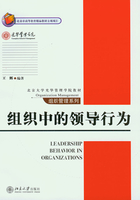
参考文献
[1] 〔美〕史蒂芬·罗宾斯,《组织行为学》(第七版),中国人民大学出版社,1997年版。
[2] 郭全中、付晨,“浅谈中国权变理论及其形式”,《甘肃行政学院学报》,2000年第35期,第37—39页。
[3] 凌文辁、郑晓明、张治灿、方俐洛,“组织心理学的新进展”,《应用心理学》,1997年第3卷第1期,第11—18页。
[4] 麻尧宾,“《周易》与企业权变管理”,《现代管理科学》,2004年第1期,第31—32页。
[5] 彭世勇,“跨文化研究理论透视——从霍夫斯塔德到费尔南德斯”,《西安外国语学院学报》,2004年9月第12卷第3期。
[6] 王垒,《组织管理心理学》,北京大学出版社,1993年版,第189—191页。
[7] 袁凌、李敬、吴文华,《组织行为学》,湖南大学出版社,2003年版,第131—132页。
[8] 张再林,“《孙子兵法》与现代管理思想”,《西北大学学报》(哲学社会科学版),1997年第3期,第27页。
[9] 郑晓明,《组织行为学》,经济科学出版社,2002年版,第262—268页。
[10] 周业柱,“为将之道,重在权变——《孙子兵法》中的领导权变理论浅析”,《行政与法》,2001年第6期,第81—82页。
[11] Alder, N.J., International Dimensions ofOrganizational Behavior, Cincinnati, OH:South-Western College Publishing,1997.
[12] Bennett, M., “Testing Management Theories Culturally”, Journal ofApplied Psychology,1997,62,578—581.
[13] Dorfman, P.W., “International and Cross-cultural Leadership Research”, in B.J. Punnet and O.Shenkar(eds.), Handbook for International Management Research, Oxford: Blackwell,1996,267—349.
[14] Evans, M.G., “The Effects of Supervisory Behavior on the Path-goal Relationship”, Organizational Behavior and Human Performance,1970,5,277—298.
[15] Fiedler, F.E., “A Contingency Model of Leadership Effectiveness”, in L.Berkowitz (Ed.), Advances in Experimental Social Psychology, New York: McGraw-Hill,1964,149—190.
[16] Fiedler, F.E., “Leadership Experience and Leader Performance: Another Hypothesis Shot to Hell”, Organizational Behavior and Human Performance,1970,5,1—14.
[17] Fiedler, F.E., “The Contribution of Cognitive Resources to Leadership Performance”, Journal ofApplied Social Psychology,1986,16,532—548.
[18] Fiedler, F.E., A Theory ofLeadership Effectiveness, New York: McGraw-Hill,1967.
[19] Hersey, P., &Blanchard, K.H., The Management ofOrganizational Behavior(4th ed.), Englewood Cliffs, NJ: Prentice-Hall,1984.
[20] Hofstede, G., Culture's Consequences:International Differences in Work-related Values,London: Sage,1980.
[21] House, R.J., “A Path-goal Theory of Leader Effectiveness”, Administrative Science Quarterly,1971,16,321—339.
[22] House, R.J., “Path-goal Theory of Leadership: Lessons, Legacy, and a Reformulated Theory”, Leadership Quarterly,1996,7,323—357.
[23] House, R.J., Hanges, P.J., Ruiz-Quintanilla, S.A., Dorfman, P.W., Javidan, M., Diskson, M.and Associates, “Cultural Influences on Leadership and Organizations: Projects GLOBE”, in W.H.Mobley, M.J.Gessner &V.Arnold(Eds.), Advances in Globle Leadership,1999,171—233.
[24] Kennedy, J.K., Jr., “Middle LPC Leaders and the Contingency Model of Leadership Effectiveness”, Organizational Behavior and Human Performance”,1982,30,1—14.
[25] Kerr, S., &Jermier, J.M., “Substitutes for Leadership: Their Meaning and Measurement”, Organizational Behavior and Human Performance,1978,22,375—403.
[26] Lord, R.G., &Maher, K.J., Leadership and Information Processing: Linking Perceptions and Performance, Boston: Unwin-Hyman,1991.
[27] Trompenaars, F., Riding the Waves ofCulture, London: Brealey,1993.
[28] Vroom, V.H., Work and Motivation, New York: Wiley,1964.
[29] Yukl, G., Leadership in Organizations,清华大学出版社,2001年版。